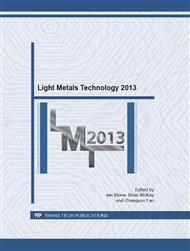p.291
p.296
p.301
p.306
p.311
p.316
p.321
p.326
p.331
Influence of a Novel Master Alloy Addition on the Grain Refinement of Al-Si Cast Alloys
Abstract:
The grain refinement practice using Ti based chemical additions is well established for wrought Al alloys, especially in the last few decades. In the case of Al-Si casting alloys the practice of adding grain refiners and the impact on castability is not well established in industries. The main reason is the chemical instability of conventionally known Ti based grain refiner which reacts with silicon forming intermetallic phases. Recently, researchers at Brunel University have identified a novel chemical composition that can refine the grain structure of Al-Si alloys in an effective way. Over the last year, this novel grain refiner in the form of master alloy was developed and tested in various Al-Si cast alloys that are commonly used in industry. Significant grain refinement is obtained when the master alloy is added to the liquid metal prior to casting. Moreover, the grain size of the Al-Si cast alloys is observed to be less sensitive to cooling rate when the master alloy is added. In this work, the influence of addition of the master alloy on microstructural evolution of various Al-Si alloys cast under various cooling rates is presented.
Info:
Periodical:
Pages:
311-315
Citation:
Online since:
July 2013
Authors:
Price:
Сopyright:
© 2013 Trans Tech Publications Ltd. All Rights Reserved
Share:
Citation:


